Strategic Management and Change Analysis of the Heineken Case Study
VerifiedAdded on 2020/07/22
|10
|3079
|131
Report
AI Summary
This report provides a strategic management and change analysis of Heineken within the European brewing industry. The analysis utilizes PESTEL and Porter's Five Forces frameworks to assess the external environment and competitive forces. A SWOT analysis evaluates Heineken's strengths, weaknesses, opportunities, and threats. The report also applies Kotter's change management model to address industry challenges. The study concludes that the European brewing industry is experiencing a decline due to factors like governmental regulations, changing consumer preferences, and the rise of substitute products. The report includes an executive summary, introduction, and conclusion, supported by references. The report examines the impact of these trends on Heineken and provides strategic recommendations for the company to adapt to the changing market conditions.
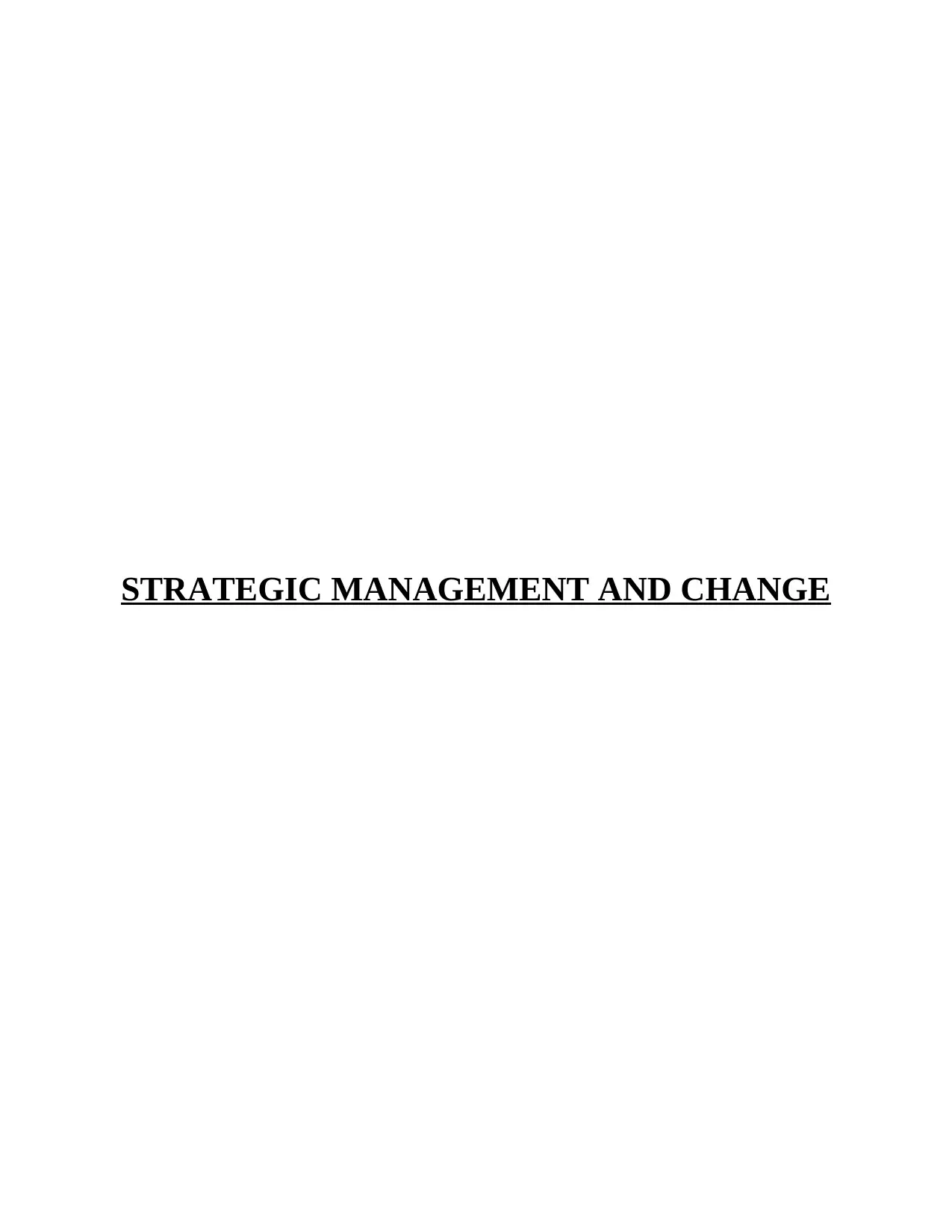
STRATEGIC MANAGEMENT AND CHANGE
Paraphrase This Document
Need a fresh take? Get an instant paraphrase of this document with our AI Paraphraser
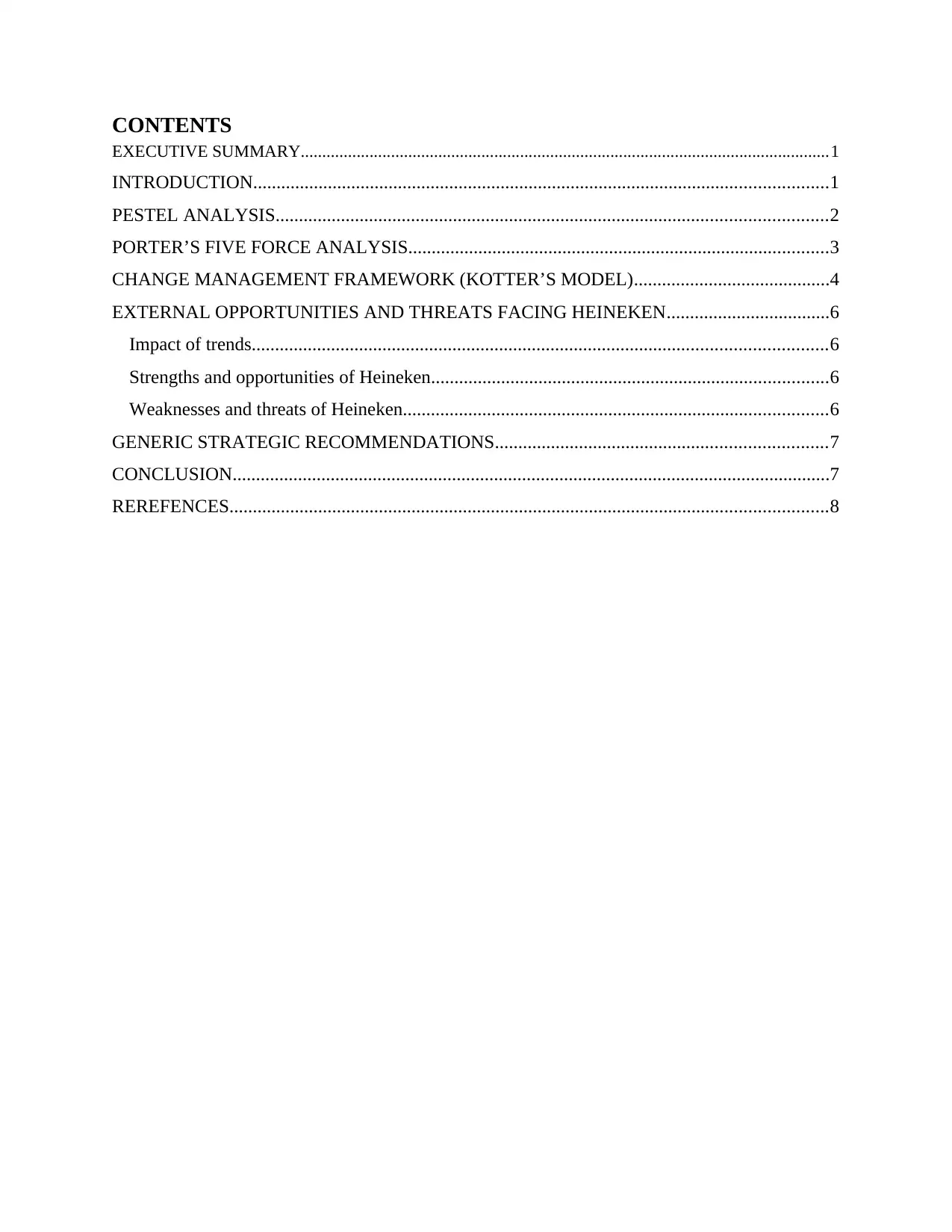
CONTENTS
EXECUTIVE SUMMARY...........................................................................................................................1
INTRODUCTION...........................................................................................................................1
PESTEL ANALYSIS......................................................................................................................2
PORTER’S FIVE FORCE ANALYSIS..........................................................................................3
CHANGE MANAGEMENT FRAMEWORK (KOTTER’S MODEL)..........................................4
EXTERNAL OPPORTUNITIES AND THREATS FACING HEINEKEN...................................6
Impact of trends...........................................................................................................................6
Strengths and opportunities of Heineken.....................................................................................6
Weaknesses and threats of Heineken...........................................................................................6
GENERIC STRATEGIC RECOMMENDATIONS.......................................................................7
CONCLUSION................................................................................................................................7
REREFENCES................................................................................................................................8
EXECUTIVE SUMMARY...........................................................................................................................1
INTRODUCTION...........................................................................................................................1
PESTEL ANALYSIS......................................................................................................................2
PORTER’S FIVE FORCE ANALYSIS..........................................................................................3
CHANGE MANAGEMENT FRAMEWORK (KOTTER’S MODEL)..........................................4
EXTERNAL OPPORTUNITIES AND THREATS FACING HEINEKEN...................................6
Impact of trends...........................................................................................................................6
Strengths and opportunities of Heineken.....................................................................................6
Weaknesses and threats of Heineken...........................................................................................6
GENERIC STRATEGIC RECOMMENDATIONS.......................................................................7
CONCLUSION................................................................................................................................7
REREFENCES................................................................................................................................8
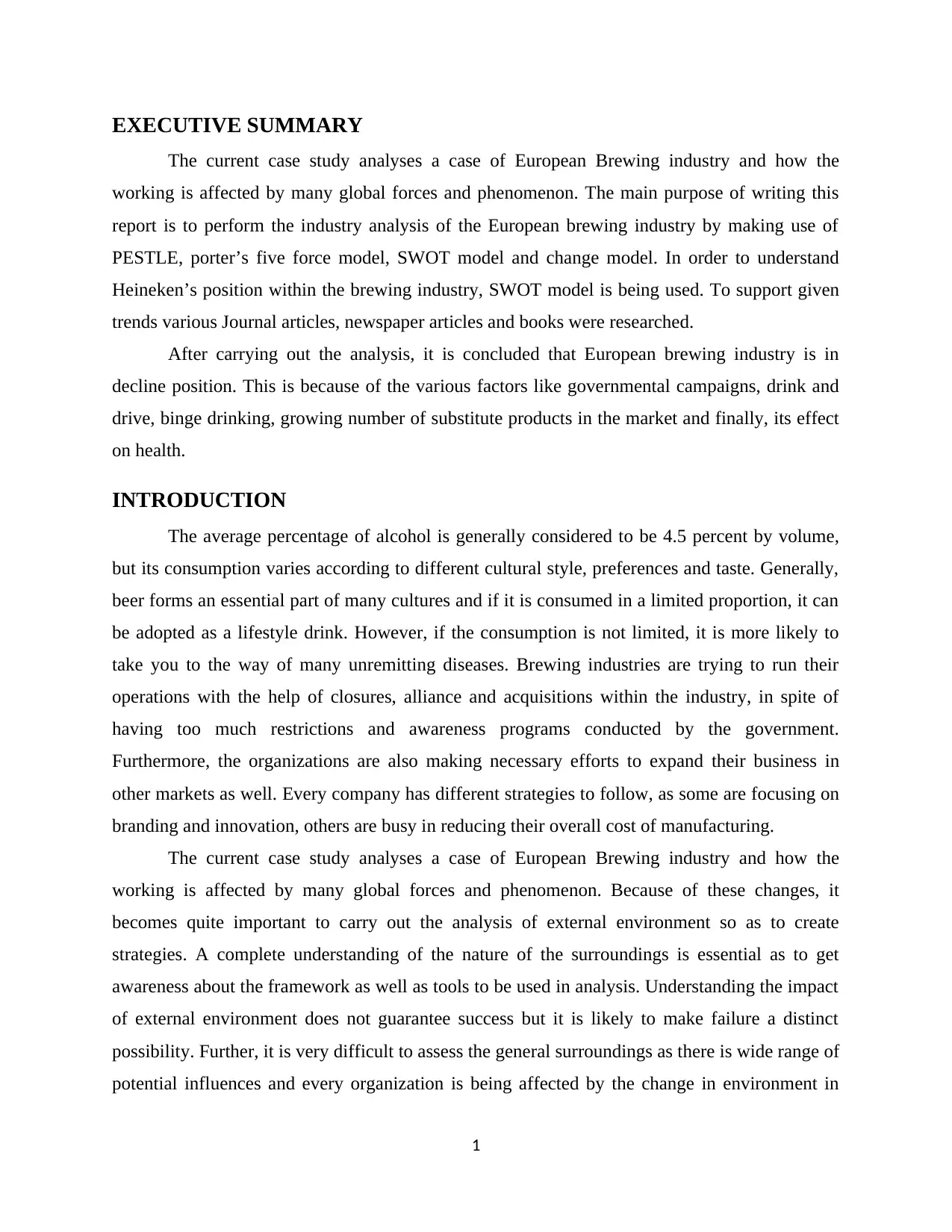
EXECUTIVE SUMMARY
The current case study analyses a case of European Brewing industry and how the
working is affected by many global forces and phenomenon. The main purpose of writing this
report is to perform the industry analysis of the European brewing industry by making use of
PESTLE, porter’s five force model, SWOT model and change model. In order to understand
Heineken’s position within the brewing industry, SWOT model is being used. To support given
trends various Journal articles, newspaper articles and books were researched.
After carrying out the analysis, it is concluded that European brewing industry is in
decline position. This is because of the various factors like governmental campaigns, drink and
drive, binge drinking, growing number of substitute products in the market and finally, its effect
on health.
INTRODUCTION
The average percentage of alcohol is generally considered to be 4.5 percent by volume,
but its consumption varies according to different cultural style, preferences and taste. Generally,
beer forms an essential part of many cultures and if it is consumed in a limited proportion, it can
be adopted as a lifestyle drink. However, if the consumption is not limited, it is more likely to
take you to the way of many unremitting diseases. Brewing industries are trying to run their
operations with the help of closures, alliance and acquisitions within the industry, in spite of
having too much restrictions and awareness programs conducted by the government.
Furthermore, the organizations are also making necessary efforts to expand their business in
other markets as well. Every company has different strategies to follow, as some are focusing on
branding and innovation, others are busy in reducing their overall cost of manufacturing.
The current case study analyses a case of European Brewing industry and how the
working is affected by many global forces and phenomenon. Because of these changes, it
becomes quite important to carry out the analysis of external environment so as to create
strategies. A complete understanding of the nature of the surroundings is essential as to get
awareness about the framework as well as tools to be used in analysis. Understanding the impact
of external environment does not guarantee success but it is likely to make failure a distinct
possibility. Further, it is very difficult to assess the general surroundings as there is wide range of
potential influences and every organization is being affected by the change in environment in
1
The current case study analyses a case of European Brewing industry and how the
working is affected by many global forces and phenomenon. The main purpose of writing this
report is to perform the industry analysis of the European brewing industry by making use of
PESTLE, porter’s five force model, SWOT model and change model. In order to understand
Heineken’s position within the brewing industry, SWOT model is being used. To support given
trends various Journal articles, newspaper articles and books were researched.
After carrying out the analysis, it is concluded that European brewing industry is in
decline position. This is because of the various factors like governmental campaigns, drink and
drive, binge drinking, growing number of substitute products in the market and finally, its effect
on health.
INTRODUCTION
The average percentage of alcohol is generally considered to be 4.5 percent by volume,
but its consumption varies according to different cultural style, preferences and taste. Generally,
beer forms an essential part of many cultures and if it is consumed in a limited proportion, it can
be adopted as a lifestyle drink. However, if the consumption is not limited, it is more likely to
take you to the way of many unremitting diseases. Brewing industries are trying to run their
operations with the help of closures, alliance and acquisitions within the industry, in spite of
having too much restrictions and awareness programs conducted by the government.
Furthermore, the organizations are also making necessary efforts to expand their business in
other markets as well. Every company has different strategies to follow, as some are focusing on
branding and innovation, others are busy in reducing their overall cost of manufacturing.
The current case study analyses a case of European Brewing industry and how the
working is affected by many global forces and phenomenon. Because of these changes, it
becomes quite important to carry out the analysis of external environment so as to create
strategies. A complete understanding of the nature of the surroundings is essential as to get
awareness about the framework as well as tools to be used in analysis. Understanding the impact
of external environment does not guarantee success but it is likely to make failure a distinct
possibility. Further, it is very difficult to assess the general surroundings as there is wide range of
potential influences and every organization is being affected by the change in environment in
1
⊘ This is a preview!⊘
Do you want full access?
Subscribe today to unlock all pages.

Trusted by 1+ million students worldwide

diverse ways. By making use of PESTEL analysis, the management can identify the biggest
influences on the strategy and can concentrate on those trends that affect the future of the
organization.
PESTEL ANALYSIS
Political factor – Government has started many campaigns to aware the public about the
negative effects of consuming alcohol. Further, there are many restrictions imposed on
the consumption of beer as well as products related to alcohol. In addition, if any person
is predisposed by alcohol in doing any offense than they are charged high fine.
Economic factor – Due to many restrictions imposed by government, there is increase in
the sales of alcohol in supermarket. However, due to these precincts there is a
considerable decrease in the sales in pubs and clubs. Organizations are reducing costs in
order to achieve the economies of scale. European Brewing companies are engaging in
many marketing practices to expand their market by introducing premium product,
mergers and acquisitions. Many super markets are now offering pricing offers. Heineken
is also facing difficulties related to the packaging cost.
Socio-cultural factor – Customers are now becoming health conscious and thereby,
consuming less alcohol. Additionally, they are showing unfriendly and violent behavior
towards those who are binge drinkers. In the north European market, people have now
started drinking wines. As drinking in clubs as well as pubs has been reduced, the
business of the brewing industry has also effected.
Technology factor – For the purpose of achieving the efficiency, economies of scale, and
cost reduction organizations are transferring their technology and expertise. For
increasing the volume, monopolization has been done. Supportive hands of Information
technology and media are also taken into consideration.
Environmental factor – The market of European brewing industry is decreasing in United
Kingdom and Germany. On the other hand, it is increasing around the worlds with 7
percent annual growth in the market of China. The increasing sales of the retailers of
Germany are from the private brands and not because of the brewery brand. In order to
overcome the competition, mergers and acquisitions are being carried out. There is a
considerable shift in the sales from on-trade to off-trade is also been seen.
2
influences on the strategy and can concentrate on those trends that affect the future of the
organization.
PESTEL ANALYSIS
Political factor – Government has started many campaigns to aware the public about the
negative effects of consuming alcohol. Further, there are many restrictions imposed on
the consumption of beer as well as products related to alcohol. In addition, if any person
is predisposed by alcohol in doing any offense than they are charged high fine.
Economic factor – Due to many restrictions imposed by government, there is increase in
the sales of alcohol in supermarket. However, due to these precincts there is a
considerable decrease in the sales in pubs and clubs. Organizations are reducing costs in
order to achieve the economies of scale. European Brewing companies are engaging in
many marketing practices to expand their market by introducing premium product,
mergers and acquisitions. Many super markets are now offering pricing offers. Heineken
is also facing difficulties related to the packaging cost.
Socio-cultural factor – Customers are now becoming health conscious and thereby,
consuming less alcohol. Additionally, they are showing unfriendly and violent behavior
towards those who are binge drinkers. In the north European market, people have now
started drinking wines. As drinking in clubs as well as pubs has been reduced, the
business of the brewing industry has also effected.
Technology factor – For the purpose of achieving the efficiency, economies of scale, and
cost reduction organizations are transferring their technology and expertise. For
increasing the volume, monopolization has been done. Supportive hands of Information
technology and media are also taken into consideration.
Environmental factor – The market of European brewing industry is decreasing in United
Kingdom and Germany. On the other hand, it is increasing around the worlds with 7
percent annual growth in the market of China. The increasing sales of the retailers of
Germany are from the private brands and not because of the brewery brand. In order to
overcome the competition, mergers and acquisitions are being carried out. There is a
considerable shift in the sales from on-trade to off-trade is also been seen.
2
Paraphrase This Document
Need a fresh take? Get an instant paraphrase of this document with our AI Paraphraser
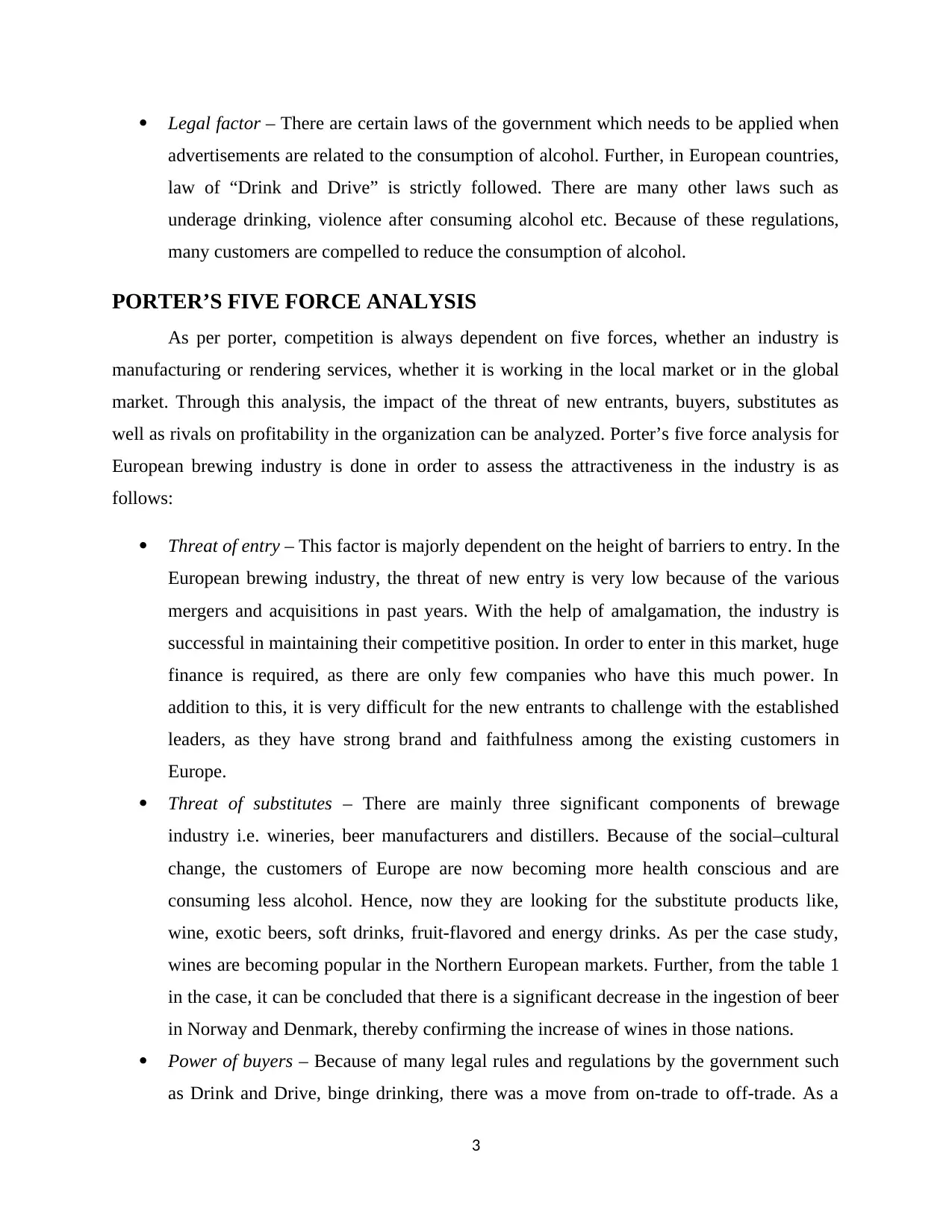
Legal factor – There are certain laws of the government which needs to be applied when
advertisements are related to the consumption of alcohol. Further, in European countries,
law of “Drink and Drive” is strictly followed. There are many other laws such as
underage drinking, violence after consuming alcohol etc. Because of these regulations,
many customers are compelled to reduce the consumption of alcohol.
PORTER’S FIVE FORCE ANALYSIS
As per porter, competition is always dependent on five forces, whether an industry is
manufacturing or rendering services, whether it is working in the local market or in the global
market. Through this analysis, the impact of the threat of new entrants, buyers, substitutes as
well as rivals on profitability in the organization can be analyzed. Porter’s five force analysis for
European brewing industry is done in order to assess the attractiveness in the industry is as
follows:
Threat of entry – This factor is majorly dependent on the height of barriers to entry. In the
European brewing industry, the threat of new entry is very low because of the various
mergers and acquisitions in past years. With the help of amalgamation, the industry is
successful in maintaining their competitive position. In order to enter in this market, huge
finance is required, as there are only few companies who have this much power. In
addition to this, it is very difficult for the new entrants to challenge with the established
leaders, as they have strong brand and faithfulness among the existing customers in
Europe.
Threat of substitutes – There are mainly three significant components of brewage
industry i.e. wineries, beer manufacturers and distillers. Because of the social–cultural
change, the customers of Europe are now becoming more health conscious and are
consuming less alcohol. Hence, now they are looking for the substitute products like,
wine, exotic beers, soft drinks, fruit-flavored and energy drinks. As per the case study,
wines are becoming popular in the Northern European markets. Further, from the table 1
in the case, it can be concluded that there is a significant decrease in the ingestion of beer
in Norway and Denmark, thereby confirming the increase of wines in those nations.
Power of buyers – Because of many legal rules and regulations by the government such
as Drink and Drive, binge drinking, there was a move from on-trade to off-trade. As a
3
advertisements are related to the consumption of alcohol. Further, in European countries,
law of “Drink and Drive” is strictly followed. There are many other laws such as
underage drinking, violence after consuming alcohol etc. Because of these regulations,
many customers are compelled to reduce the consumption of alcohol.
PORTER’S FIVE FORCE ANALYSIS
As per porter, competition is always dependent on five forces, whether an industry is
manufacturing or rendering services, whether it is working in the local market or in the global
market. Through this analysis, the impact of the threat of new entrants, buyers, substitutes as
well as rivals on profitability in the organization can be analyzed. Porter’s five force analysis for
European brewing industry is done in order to assess the attractiveness in the industry is as
follows:
Threat of entry – This factor is majorly dependent on the height of barriers to entry. In the
European brewing industry, the threat of new entry is very low because of the various
mergers and acquisitions in past years. With the help of amalgamation, the industry is
successful in maintaining their competitive position. In order to enter in this market, huge
finance is required, as there are only few companies who have this much power. In
addition to this, it is very difficult for the new entrants to challenge with the established
leaders, as they have strong brand and faithfulness among the existing customers in
Europe.
Threat of substitutes – There are mainly three significant components of brewage
industry i.e. wineries, beer manufacturers and distillers. Because of the social–cultural
change, the customers of Europe are now becoming more health conscious and are
consuming less alcohol. Hence, now they are looking for the substitute products like,
wine, exotic beers, soft drinks, fruit-flavored and energy drinks. As per the case study,
wines are becoming popular in the Northern European markets. Further, from the table 1
in the case, it can be concluded that there is a significant decrease in the ingestion of beer
in Norway and Denmark, thereby confirming the increase of wines in those nations.
Power of buyers – Because of many legal rules and regulations by the government such
as Drink and Drive, binge drinking, there was a move from on-trade to off-trade. As a
3
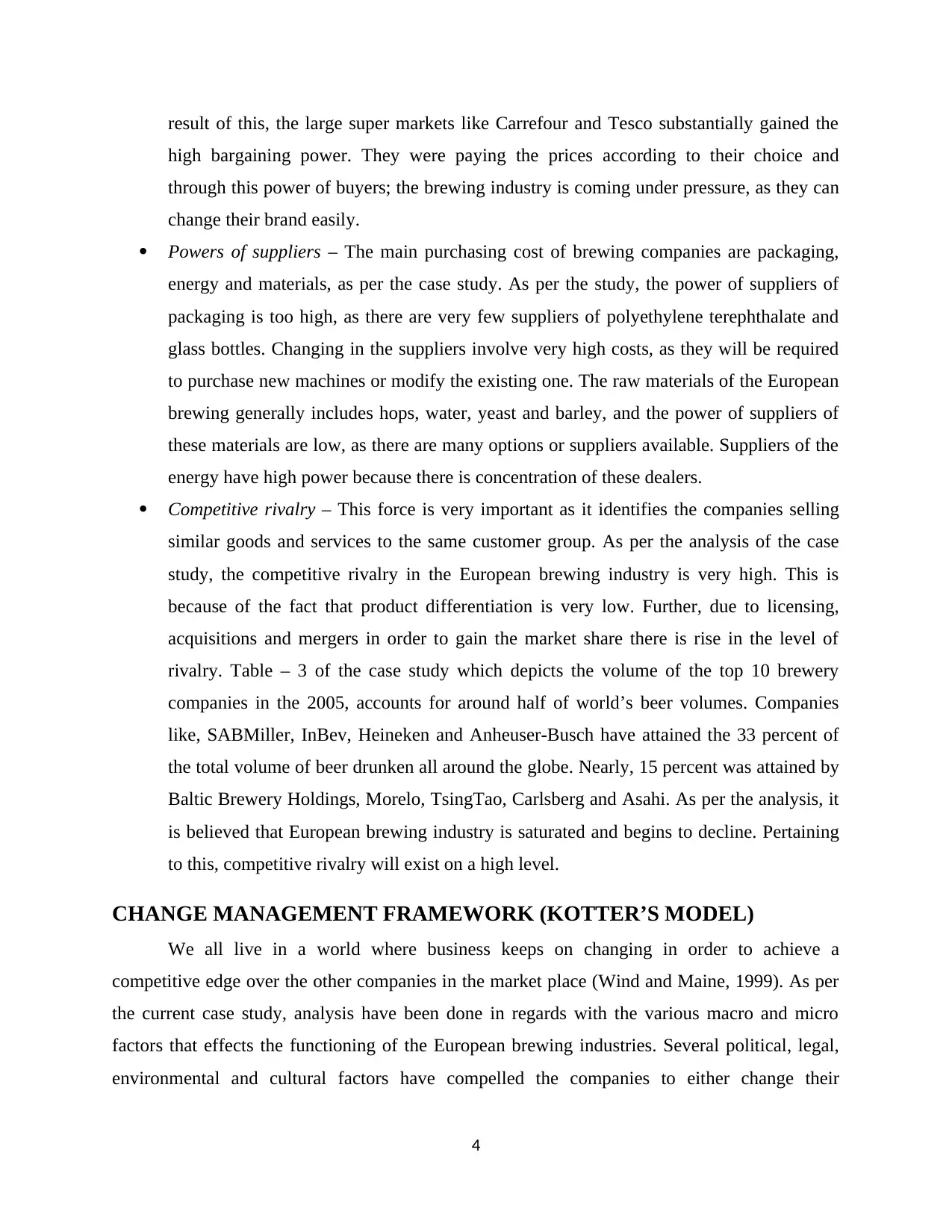
result of this, the large super markets like Carrefour and Tesco substantially gained the
high bargaining power. They were paying the prices according to their choice and
through this power of buyers; the brewing industry is coming under pressure, as they can
change their brand easily.
Powers of suppliers – The main purchasing cost of brewing companies are packaging,
energy and materials, as per the case study. As per the study, the power of suppliers of
packaging is too high, as there are very few suppliers of polyethylene terephthalate and
glass bottles. Changing in the suppliers involve very high costs, as they will be required
to purchase new machines or modify the existing one. The raw materials of the European
brewing generally includes hops, water, yeast and barley, and the power of suppliers of
these materials are low, as there are many options or suppliers available. Suppliers of the
energy have high power because there is concentration of these dealers.
Competitive rivalry – This force is very important as it identifies the companies selling
similar goods and services to the same customer group. As per the analysis of the case
study, the competitive rivalry in the European brewing industry is very high. This is
because of the fact that product differentiation is very low. Further, due to licensing,
acquisitions and mergers in order to gain the market share there is rise in the level of
rivalry. Table – 3 of the case study which depicts the volume of the top 10 brewery
companies in the 2005, accounts for around half of world’s beer volumes. Companies
like, SABMiller, InBev, Heineken and Anheuser-Busch have attained the 33 percent of
the total volume of beer drunken all around the globe. Nearly, 15 percent was attained by
Baltic Brewery Holdings, Morelo, TsingTao, Carlsberg and Asahi. As per the analysis, it
is believed that European brewing industry is saturated and begins to decline. Pertaining
to this, competitive rivalry will exist on a high level.
CHANGE MANAGEMENT FRAMEWORK (KOTTER’S MODEL)
We all live in a world where business keeps on changing in order to achieve a
competitive edge over the other companies in the market place (Wind and Maine, 1999). As per
the current case study, analysis have been done in regards with the various macro and micro
factors that effects the functioning of the European brewing industries. Several political, legal,
environmental and cultural factors have compelled the companies to either change their
4
high bargaining power. They were paying the prices according to their choice and
through this power of buyers; the brewing industry is coming under pressure, as they can
change their brand easily.
Powers of suppliers – The main purchasing cost of brewing companies are packaging,
energy and materials, as per the case study. As per the study, the power of suppliers of
packaging is too high, as there are very few suppliers of polyethylene terephthalate and
glass bottles. Changing in the suppliers involve very high costs, as they will be required
to purchase new machines or modify the existing one. The raw materials of the European
brewing generally includes hops, water, yeast and barley, and the power of suppliers of
these materials are low, as there are many options or suppliers available. Suppliers of the
energy have high power because there is concentration of these dealers.
Competitive rivalry – This force is very important as it identifies the companies selling
similar goods and services to the same customer group. As per the analysis of the case
study, the competitive rivalry in the European brewing industry is very high. This is
because of the fact that product differentiation is very low. Further, due to licensing,
acquisitions and mergers in order to gain the market share there is rise in the level of
rivalry. Table – 3 of the case study which depicts the volume of the top 10 brewery
companies in the 2005, accounts for around half of world’s beer volumes. Companies
like, SABMiller, InBev, Heineken and Anheuser-Busch have attained the 33 percent of
the total volume of beer drunken all around the globe. Nearly, 15 percent was attained by
Baltic Brewery Holdings, Morelo, TsingTao, Carlsberg and Asahi. As per the analysis, it
is believed that European brewing industry is saturated and begins to decline. Pertaining
to this, competitive rivalry will exist on a high level.
CHANGE MANAGEMENT FRAMEWORK (KOTTER’S MODEL)
We all live in a world where business keeps on changing in order to achieve a
competitive edge over the other companies in the market place (Wind and Maine, 1999). As per
the current case study, analysis have been done in regards with the various macro and micro
factors that effects the functioning of the European brewing industries. Several political, legal,
environmental and cultural factors have compelled the companies to either change their
4
⊘ This is a preview!⊘
Do you want full access?
Subscribe today to unlock all pages.

Trusted by 1+ million students worldwide
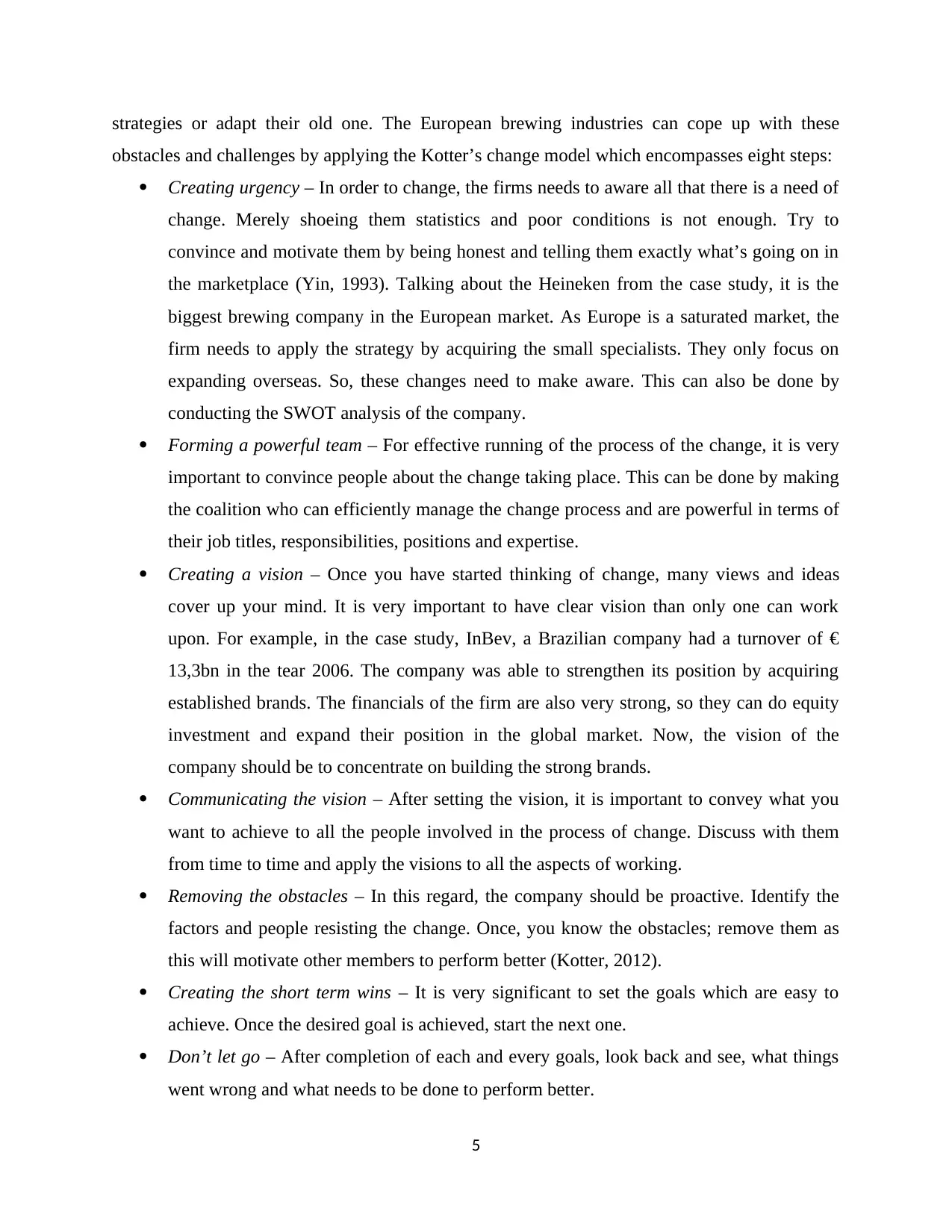
strategies or adapt their old one. The European brewing industries can cope up with these
obstacles and challenges by applying the Kotter’s change model which encompasses eight steps:
Creating urgency – In order to change, the firms needs to aware all that there is a need of
change. Merely shoeing them statistics and poor conditions is not enough. Try to
convince and motivate them by being honest and telling them exactly what’s going on in
the marketplace (Yin, 1993). Talking about the Heineken from the case study, it is the
biggest brewing company in the European market. As Europe is a saturated market, the
firm needs to apply the strategy by acquiring the small specialists. They only focus on
expanding overseas. So, these changes need to make aware. This can also be done by
conducting the SWOT analysis of the company.
Forming a powerful team – For effective running of the process of the change, it is very
important to convince people about the change taking place. This can be done by making
the coalition who can efficiently manage the change process and are powerful in terms of
their job titles, responsibilities, positions and expertise.
Creating a vision – Once you have started thinking of change, many views and ideas
cover up your mind. It is very important to have clear vision than only one can work
upon. For example, in the case study, InBev, a Brazilian company had a turnover of €
13,3bn in the tear 2006. The company was able to strengthen its position by acquiring
established brands. The financials of the firm are also very strong, so they can do equity
investment and expand their position in the global market. Now, the vision of the
company should be to concentrate on building the strong brands.
Communicating the vision – After setting the vision, it is important to convey what you
want to achieve to all the people involved in the process of change. Discuss with them
from time to time and apply the visions to all the aspects of working.
Removing the obstacles – In this regard, the company should be proactive. Identify the
factors and people resisting the change. Once, you know the obstacles; remove them as
this will motivate other members to perform better (Kotter, 2012).
Creating the short term wins – It is very significant to set the goals which are easy to
achieve. Once the desired goal is achieved, start the next one.
Don’t let go – After completion of each and every goals, look back and see, what things
went wrong and what needs to be done to perform better.
5
obstacles and challenges by applying the Kotter’s change model which encompasses eight steps:
Creating urgency – In order to change, the firms needs to aware all that there is a need of
change. Merely shoeing them statistics and poor conditions is not enough. Try to
convince and motivate them by being honest and telling them exactly what’s going on in
the marketplace (Yin, 1993). Talking about the Heineken from the case study, it is the
biggest brewing company in the European market. As Europe is a saturated market, the
firm needs to apply the strategy by acquiring the small specialists. They only focus on
expanding overseas. So, these changes need to make aware. This can also be done by
conducting the SWOT analysis of the company.
Forming a powerful team – For effective running of the process of the change, it is very
important to convince people about the change taking place. This can be done by making
the coalition who can efficiently manage the change process and are powerful in terms of
their job titles, responsibilities, positions and expertise.
Creating a vision – Once you have started thinking of change, many views and ideas
cover up your mind. It is very important to have clear vision than only one can work
upon. For example, in the case study, InBev, a Brazilian company had a turnover of €
13,3bn in the tear 2006. The company was able to strengthen its position by acquiring
established brands. The financials of the firm are also very strong, so they can do equity
investment and expand their position in the global market. Now, the vision of the
company should be to concentrate on building the strong brands.
Communicating the vision – After setting the vision, it is important to convey what you
want to achieve to all the people involved in the process of change. Discuss with them
from time to time and apply the visions to all the aspects of working.
Removing the obstacles – In this regard, the company should be proactive. Identify the
factors and people resisting the change. Once, you know the obstacles; remove them as
this will motivate other members to perform better (Kotter, 2012).
Creating the short term wins – It is very significant to set the goals which are easy to
achieve. Once the desired goal is achieved, start the next one.
Don’t let go – After completion of each and every goals, look back and see, what things
went wrong and what needs to be done to perform better.
5
Paraphrase This Document
Need a fresh take? Get an instant paraphrase of this document with our AI Paraphraser
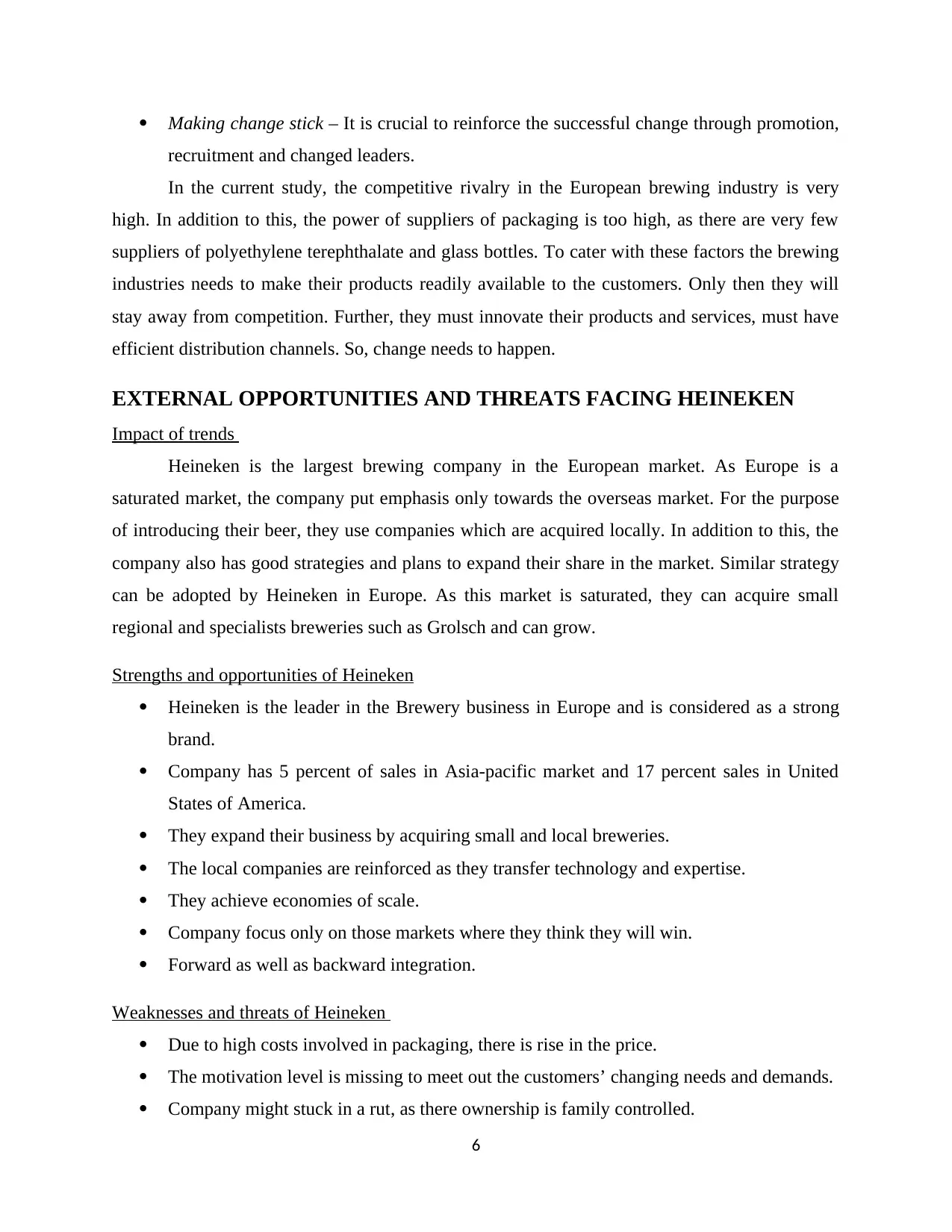
Making change stick – It is crucial to reinforce the successful change through promotion,
recruitment and changed leaders.
In the current study, the competitive rivalry in the European brewing industry is very
high. In addition to this, the power of suppliers of packaging is too high, as there are very few
suppliers of polyethylene terephthalate and glass bottles. To cater with these factors the brewing
industries needs to make their products readily available to the customers. Only then they will
stay away from competition. Further, they must innovate their products and services, must have
efficient distribution channels. So, change needs to happen.
EXTERNAL OPPORTUNITIES AND THREATS FACING HEINEKEN
Impact of trends
Heineken is the largest brewing company in the European market. As Europe is a
saturated market, the company put emphasis only towards the overseas market. For the purpose
of introducing their beer, they use companies which are acquired locally. In addition to this, the
company also has good strategies and plans to expand their share in the market. Similar strategy
can be adopted by Heineken in Europe. As this market is saturated, they can acquire small
regional and specialists breweries such as Grolsch and can grow.
Strengths and opportunities of Heineken
Heineken is the leader in the Brewery business in Europe and is considered as a strong
brand.
Company has 5 percent of sales in Asia-pacific market and 17 percent sales in United
States of America.
They expand their business by acquiring small and local breweries.
The local companies are reinforced as they transfer technology and expertise.
They achieve economies of scale.
Company focus only on those markets where they think they will win.
Forward as well as backward integration.
Weaknesses and threats of Heineken
Due to high costs involved in packaging, there is rise in the price.
The motivation level is missing to meet out the customers’ changing needs and demands.
Company might stuck in a rut, as there ownership is family controlled.
6
recruitment and changed leaders.
In the current study, the competitive rivalry in the European brewing industry is very
high. In addition to this, the power of suppliers of packaging is too high, as there are very few
suppliers of polyethylene terephthalate and glass bottles. To cater with these factors the brewing
industries needs to make their products readily available to the customers. Only then they will
stay away from competition. Further, they must innovate their products and services, must have
efficient distribution channels. So, change needs to happen.
EXTERNAL OPPORTUNITIES AND THREATS FACING HEINEKEN
Impact of trends
Heineken is the largest brewing company in the European market. As Europe is a
saturated market, the company put emphasis only towards the overseas market. For the purpose
of introducing their beer, they use companies which are acquired locally. In addition to this, the
company also has good strategies and plans to expand their share in the market. Similar strategy
can be adopted by Heineken in Europe. As this market is saturated, they can acquire small
regional and specialists breweries such as Grolsch and can grow.
Strengths and opportunities of Heineken
Heineken is the leader in the Brewery business in Europe and is considered as a strong
brand.
Company has 5 percent of sales in Asia-pacific market and 17 percent sales in United
States of America.
They expand their business by acquiring small and local breweries.
The local companies are reinforced as they transfer technology and expertise.
They achieve economies of scale.
Company focus only on those markets where they think they will win.
Forward as well as backward integration.
Weaknesses and threats of Heineken
Due to high costs involved in packaging, there is rise in the price.
The motivation level is missing to meet out the customers’ changing needs and demands.
Company might stuck in a rut, as there ownership is family controlled.
6
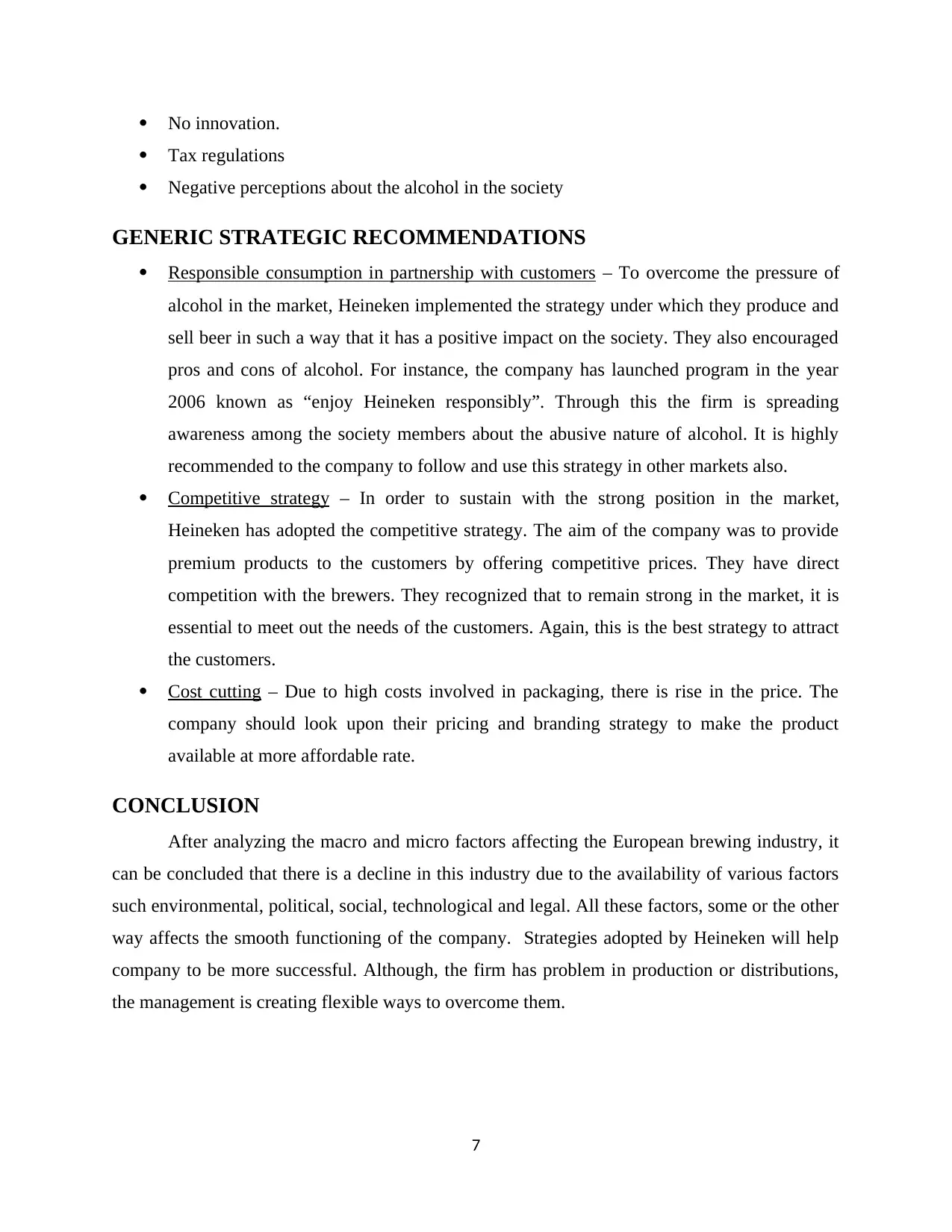
No innovation.
Tax regulations
Negative perceptions about the alcohol in the society
GENERIC STRATEGIC RECOMMENDATIONS
Responsible consumption in partnership with customers – To overcome the pressure of
alcohol in the market, Heineken implemented the strategy under which they produce and
sell beer in such a way that it has a positive impact on the society. They also encouraged
pros and cons of alcohol. For instance, the company has launched program in the year
2006 known as “enjoy Heineken responsibly”. Through this the firm is spreading
awareness among the society members about the abusive nature of alcohol. It is highly
recommended to the company to follow and use this strategy in other markets also.
Competitive strategy – In order to sustain with the strong position in the market,
Heineken has adopted the competitive strategy. The aim of the company was to provide
premium products to the customers by offering competitive prices. They have direct
competition with the brewers. They recognized that to remain strong in the market, it is
essential to meet out the needs of the customers. Again, this is the best strategy to attract
the customers.
Cost cutting – Due to high costs involved in packaging, there is rise in the price. The
company should look upon their pricing and branding strategy to make the product
available at more affordable rate.
CONCLUSION
After analyzing the macro and micro factors affecting the European brewing industry, it
can be concluded that there is a decline in this industry due to the availability of various factors
such environmental, political, social, technological and legal. All these factors, some or the other
way affects the smooth functioning of the company. Strategies adopted by Heineken will help
company to be more successful. Although, the firm has problem in production or distributions,
the management is creating flexible ways to overcome them.
7
Tax regulations
Negative perceptions about the alcohol in the society
GENERIC STRATEGIC RECOMMENDATIONS
Responsible consumption in partnership with customers – To overcome the pressure of
alcohol in the market, Heineken implemented the strategy under which they produce and
sell beer in such a way that it has a positive impact on the society. They also encouraged
pros and cons of alcohol. For instance, the company has launched program in the year
2006 known as “enjoy Heineken responsibly”. Through this the firm is spreading
awareness among the society members about the abusive nature of alcohol. It is highly
recommended to the company to follow and use this strategy in other markets also.
Competitive strategy – In order to sustain with the strong position in the market,
Heineken has adopted the competitive strategy. The aim of the company was to provide
premium products to the customers by offering competitive prices. They have direct
competition with the brewers. They recognized that to remain strong in the market, it is
essential to meet out the needs of the customers. Again, this is the best strategy to attract
the customers.
Cost cutting – Due to high costs involved in packaging, there is rise in the price. The
company should look upon their pricing and branding strategy to make the product
available at more affordable rate.
CONCLUSION
After analyzing the macro and micro factors affecting the European brewing industry, it
can be concluded that there is a decline in this industry due to the availability of various factors
such environmental, political, social, technological and legal. All these factors, some or the other
way affects the smooth functioning of the company. Strategies adopted by Heineken will help
company to be more successful. Although, the firm has problem in production or distributions,
the management is creating flexible ways to overcome them.
7
⊘ This is a preview!⊘
Do you want full access?
Subscribe today to unlock all pages.

Trusted by 1+ million students worldwide
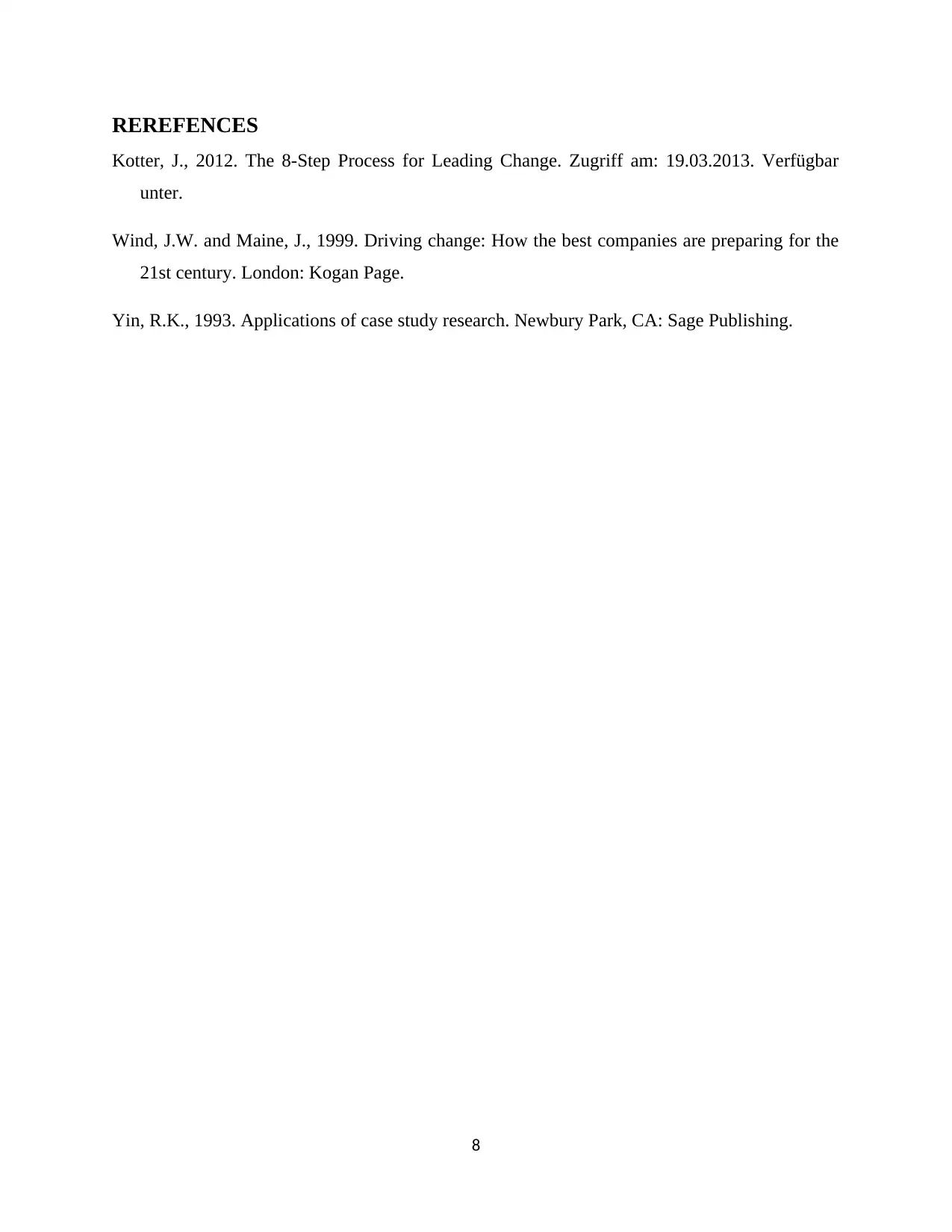
REREFENCES
Kotter, J., 2012. The 8-Step Process for Leading Change. Zugriff am: 19.03.2013. Verfügbar
unter.
Wind, J.W. and Maine, J., 1999. Driving change: How the best companies are preparing for the
21st century. London: Kogan Page.
Yin, R.K., 1993. Applications of case study research. Newbury Park, CA: Sage Publishing.
8
Kotter, J., 2012. The 8-Step Process for Leading Change. Zugriff am: 19.03.2013. Verfügbar
unter.
Wind, J.W. and Maine, J., 1999. Driving change: How the best companies are preparing for the
21st century. London: Kogan Page.
Yin, R.K., 1993. Applications of case study research. Newbury Park, CA: Sage Publishing.
8
1 out of 10
Related Documents
Your All-in-One AI-Powered Toolkit for Academic Success.
+13062052269
info@desklib.com
Available 24*7 on WhatsApp / Email
![[object Object]](/_next/static/media/star-bottom.7253800d.svg)
Unlock your academic potential
Copyright © 2020–2025 A2Z Services. All Rights Reserved. Developed and managed by ZUCOL.





